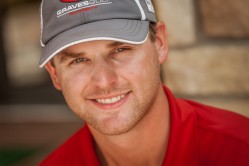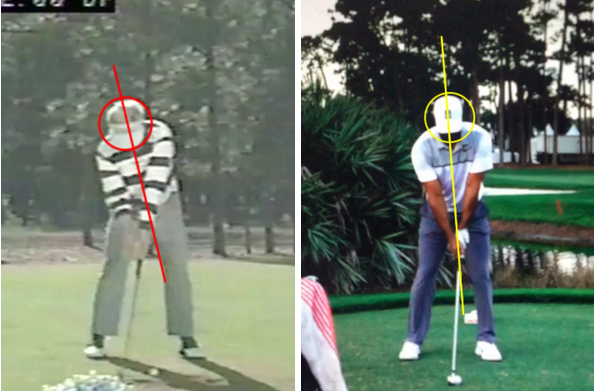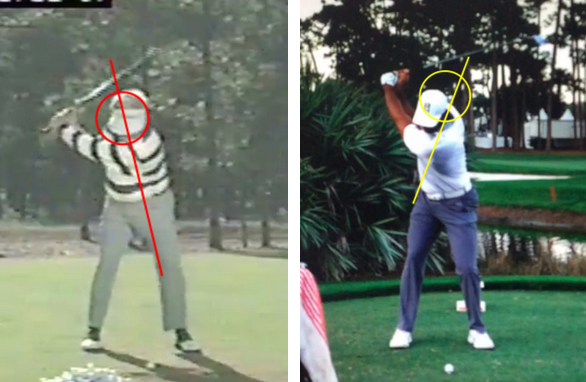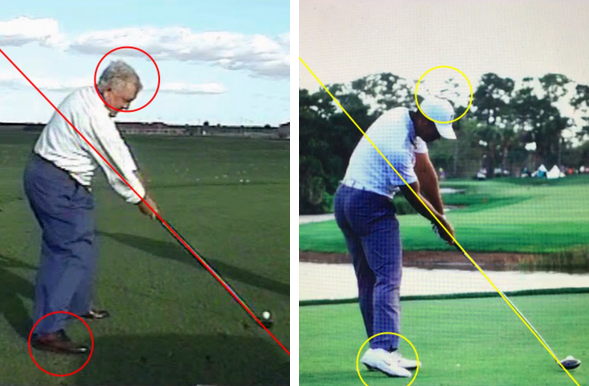By: Chandler Rusk, GGA Master Instructor

Congrats Tiger on your Masters win this past week!
So, how about a little Tiger vs. Moe for this week’s instruction.
*******************
Before we get started, it is good to know that if you are looking to simplify the golf swing the following must occur:
You must –
- Reduce lateral movement for consistency.
- Reduce rotational movement and still produce speed.
- Reduce stress on the body parts throughout the motion.
Let’s take a look at the address position to get started….

Moe and Tiger’s address position (Down-the-Line view)
No matter who we teach, we will always start with the grip & address. Simply because this is where we can eliminate the majority of the unnecessary movement.
A couple key differences here are:
- Tiger begins very close to the golf ball as Moe has more space. Notice the circles in between the hands and upper legs. This is a spatial problem for Tiger and is the root cause of all of his injuries.
- Tiger starts with his arms hanging down with the hands positioned well below where he will make the impact, this is also known as a two-plane swing. Moe starts with the club shaft on the same plane that he will make the impact – known as The Single Plane.

Face-On Address Position Above
All good ball strikers will have 25 degrees of side bend at address. Side bend is the tilt of the spine away from the target at address.
As you can see above, Tiger begins in a very straight up-and-down position (roughly 4 degrees of side bend).
Moe always began with between 15-20 degrees of side bend at address. This allowed him to maintain his head position in the backswing (see below).

Top of the Backswing Position (Face-On View)
The address position and backswing rotations are paramount in developing consistency in the golf swing. It allows the body to transition properly to the initial part of the downswing.
Key things to observe in the above images:
- Head Movement
Since Tiger only has about 4 degrees of side bend at address, he is forced to create more in the backswing. This is a built-in compensation to his swing and what you will see with most conventional golfers. The head is forced down and back in the backswing. You can see that Moe’s head has stayed in position.
- Torso Rotation
When the head position moves down and back, the torso is forced to over-rotate. Tiger’s torso rotation is past 90 degrees at the top of his backswing which causes his arms to get trapped behind him in the downswing.

Impact Positions Above (Face-On View)
The 2nd most important way we could help Tiger, other than his address position, is how he gets to impact.
Since Tiger begins very close to the golf ball, his lower body is forced to lift and rotate to clear for his arms and hands. He snaps his left leg straight which puts immense stress on the lower part of the leg and also the lower back. All while his head has gone down and back.
When the lower body is going up but the upper body is going down, this is called compression and shear of the spine.
Remember that Moe develops space away from the golf ball at address. Since there is space, Moe was able to rotate his hips down and forward into a flexed lead knee. When the lead knee is flexed at impact, it takes all of the stress off the lower part of the leg and the back.
Side Note – In our opinion – the #1 Training Tool to help you with proper lead knee flex is the Load-n-Fire Lead Knee Brace. You can see the video about this training tool at: CLICK HERE

Impact Positions from Down-the-Line
At impact, Tiger and Moe have returned the club to where it extends through the middle of the back. This is where 99% of golfers make the impact.
Why wouldn’t everyone start there?
With Tiger, since the left leg has snapped straight, the trail heal has no other choice but to come off the ground. This is another indication that the lower body is lifting instead of staying in posture.

To see 10 Training Videos helping with trail and lead knee flex: CLICK HERE
(Click on Load-n-Fire Drills and Tips)
************
Review of Tiger Vs Moe
- By simplifying Tiger’s address position, we could eliminate many compensations and also help reduce the stress on his body.
- Less rotation in his backswing would allow for his arms and hands to be in better position for the downswing. Tiger always fights blocked shots and snap hooks and the majority of that comes from the over-rotation in his backswing which leads to under-rotation at impact.
- With space created at address, Tiger could train to have a flexed lead knee at impact which would reduce all of the stress on his body and lead to more efficiency.

